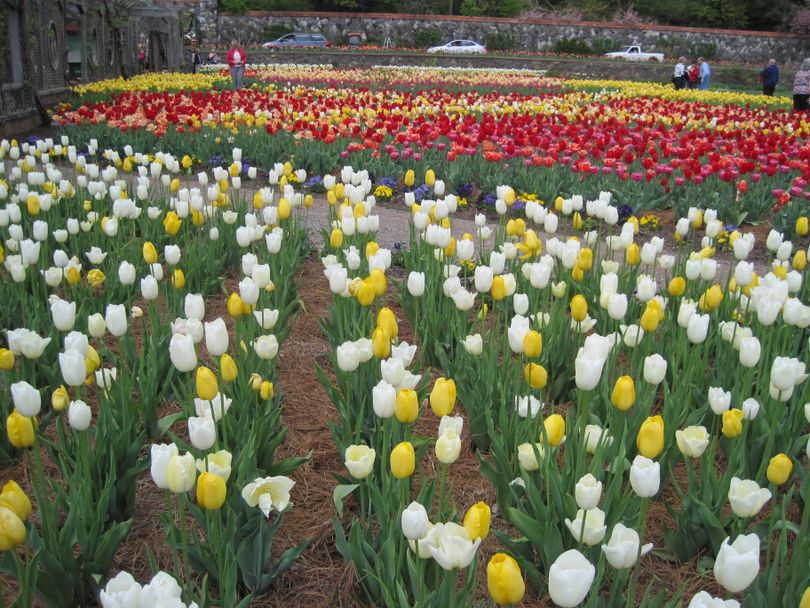Inspired by a Garden

There is a garden near my house. It is a sprawling, rolling series of gardens, really. From the pond at the bottom of the hill, to the sunken formal garden on the other side of the rise to the rose garden at the top and the meadows all around - 90 acres in all - Manito Park has been sculpted and planted and in some places groomed to create individual spaces.
Most evenings, just at twilight, I leash up the dogs and we go for a walk. It is my way of shedding the petty irritations and stresses of the day.
I am almost never alone. There are usually others - no matter what the weather - walking along the paths. Stopping to pick up fallen rose petals in the summer or leaves in autumn, reading the identifying tags at the base of perennials or sitting in the gazebo, simply letting the world move around them.
That is the power of a garden. It draws us, relaxes and inspires us. It slows us. It brings us to a stop. A garden moves us.
I was recently in Asheville, North Carolina. Asheville, if you weren’t aware of it, is home to one of the loveliest gardens in the world. The gardens at Biltmore Estate.
Designed by Frederick Law Olmstead, the patriarch of American gardens, the 125,000 acres that comprise the grounds of Biltmore, the grand country estate built by John D. Rockefeller, consist of one beautiful acre after another.
I was there in late spring, just at the peak of tulip season. Row after row of brightly colored flowers made a colorful carpet across the grounds. It was a weekday afternoon, but there were people everywhere. Families were posing and taking photos, serious photographers were intent on shooting close, almost abstract images of the interior of the flowers. The Great Smoky Mountains in the distance formed a violet band, a lavender border around the beautiful grounds. Dogwoods draped, heavy with blossoms, across pathways and hidden places. Wisteria hung like a fragrant garland over weathered wood arbors. Orchids bloomed in the greenhouses and ornate wrought iron benches were irresistible, making it impossible to walk past without stopping to breathe in the perfume and take in the view. It is an exquistitely beautiful place.
Biltmore itself can be overwhelming. The house - often called the American Castle - is the largest in the country, taking a team of craftsmen six years to build before it was finally opened in 1895.
Today, people come from all over to take a tour, to peer into the more than 250 rooms, awed by an opulent lifestyle most of us can only dream about. No one, looking at the sprawling mansion, situated in the seclusion of a private park in a small, vibrant city at the foot of the appalachian mountains, can really imagine living like that.
Ah, but out in the garden, it is another thing altogether. Who doesn’t secretly believe that he or she, if so inclined, could create a paradise? It doesn’t take 100,00 acres. It doesn’t take a bottomless fortune. You don’t need a gardner or even any particular talent. Making a garden takes only the desire to make a garden. A seed, some water and the sun do the hard work. The rest is only maintenance.
A garden, unlike a castle, is possible. A thing we secretly believe that given the time, we could manage.
I left the gardens at the Biltmore Estate with a camera full of photographs. I leave the garden near my home each evening with the fragrance of flowers still on my hands.
I leave my home each morning with daydreams of what I could do to my backyard tucked into a corner of my mind.
Cheryl-Anne Millsap is a freelance columnist for The Spokesman-Review. Her audio essays can be heard on Spokane Public Radio and public radio stations across the country. She is the author of “Home Planet: A Life in Four Seasons” and can be reached at catmillsap@gmail.com.